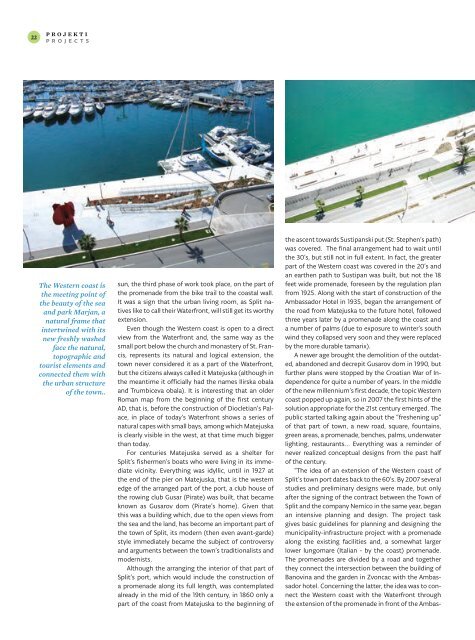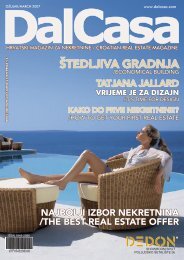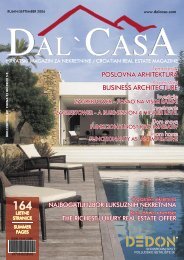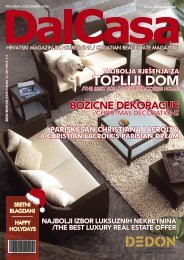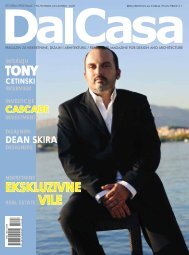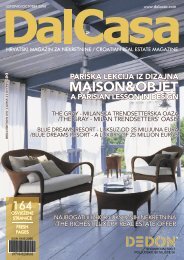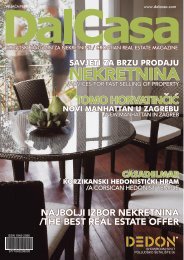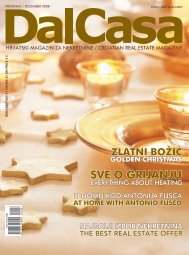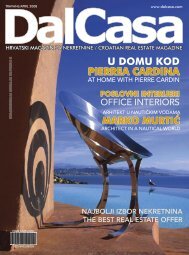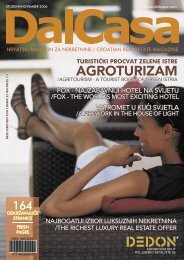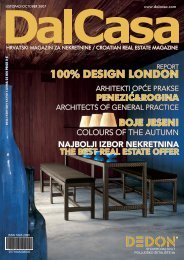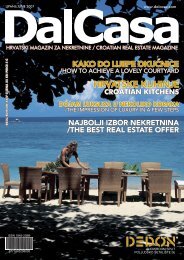Golf Park Dubrovnik - DalCasa
Golf Park Dubrovnik - DalCasa
Golf Park Dubrovnik - DalCasa
- No tags were found...
Create successful ePaper yourself
Turn your PDF publications into a flip-book with our unique Google optimized e-Paper software.
22p r o j e k t ip r o j e c t sThe Western coast isthe meeting point ofthe beauty of the seaand park Marjan, anatural frame thatintertwined with itsnew freshly washedface the natural,topographic andtourist elements andconnected them withthe urban structureof the town..sun, the third phase of work took place, on the part ofthe promenade from the bike trail to the coastal wall.It was a sign that the urban living room, as Split nativeslike to call their Waterfront, will still get its worthyextension.Even though the Western coast is open to a directview from the Waterfront and, the same way as thesmall port below the church and monastery of St. Francis,represents its natural and logical extension, thetown never considered it as a part of the Waterfront,but the citizens always called it Matejuska (although inthe meantime it officially had the names Ilirska obalaand Trumbiceva obala). It is interesting that an olderRoman map from the beginning of the first centuryAD, that is, before the construction of Diocletian’s Palace,in place of today’s Waterfront shows a series ofnatural capes with small bays, among which Matejuskais clearly visible in the west, at that time much biggerthan today.For centuries Matejuska served as a shelter forSplit’s fishermen’s boats who were living in its immediatevicinity. Everything was idyllic, until in 1927 atthe end of the pier on Matejuska, that is the westernedge of the arranged part of the port, a club house ofthe rowing club Gusar (Pirate) was built, that becameknown as Gusarov dom (Pirate’s home). Given thatthis was a building which, due to the open views fromthe sea and the land, has become an important part ofthe town of Split, its modern (then even avant-garde)style immediately became the subject of controversyand arguments between the town’s traditionalists andmodernists.Although the arranging the interior of that part ofSplit’s port, which would include the construction ofa promenade along its full length, was contemplatedalready in the mid of the 19th century, in 1860 only apart of the coast from Matejuska to the beginning ofthe ascent towards Sustipanski put (St. Stephen’s path)was covered. The final arrangement had to wait untilthe 30’s, but still not in full extent. In fact, the greaterpart of the Western coast was covered in the 20’s andan earthen path to Sustipan was built, but not the 18feet wide promenade, foreseen by the regulation planfrom 1925. Along with the start of construction of theAmbassador Hotel in 1935, began the arrangement ofthe road from Matejuska to the future hotel, followedthree years later by a promenade along the coast anda number of palms (due to exposure to winter’s southwind they collapsed very soon and they were replacedby the more durable tamarix).A newer age brought the demolition of the outdated,abandoned and decrepit Gusarov dom in 1990, butfurther plans were stopped by the Croatian War of Independencefor quite a number of years. In the middleof the new millennium’s first decade, the topic Westerncoast popped up again, so in 2007 the first hints of thesolution appropriate for the 21st century emerged. Thepublic started talking again about the “freshening up”of that part of town, a new road, square, fountains,green areas, a promenade, benches, palms, underwaterlighting, restaurants... Everything was a reminder ofnever realized conceptual designs from the past halfof the century.“The idea of an extension of the Western coast ofSplit’s town port dates back to the 60’s. By 2007 severalstudies and preliminary designs were made, but onlyafter the signing of the contract between the Town ofSplit and the company Nemico in the same year, beganan intensive planning and design. The project taskgives basic guidelines for planning and designing themunicipality-infrastructure project with a promenadealong the existing facilities and, a somewhat largerlower lungomare (Italian - by the coast) promenade.The promenades are divided by a road and togetherthey connect the intersection between the building ofBanovina and the garden in Zvoncac with the Ambassadorhotel. Concerning the latter, the idea was to connectthe Western coast with the Waterfront throughthe extension of the promenade in front of the Ambas-


